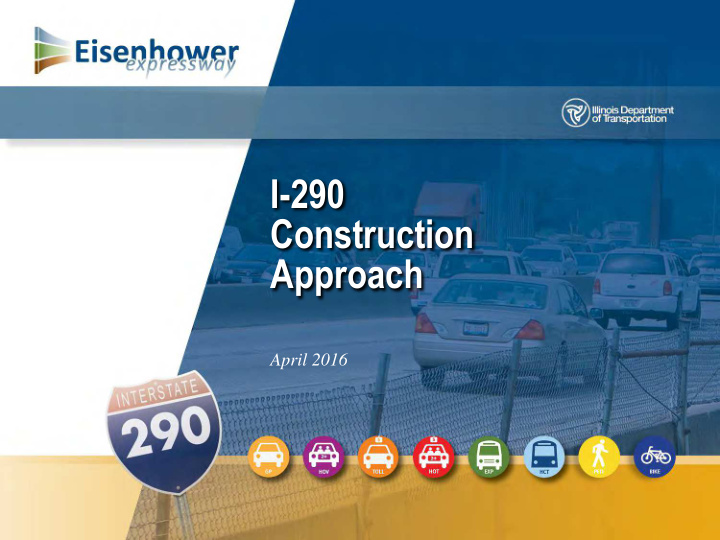



I-290 Construction Approach April 2016 1
AGENDA Project Process - Phase I, II, & III Overall guiding principles I-290 construction approach I-290 construction schedule Construction mitigation Best Practices 2
CONSTRUCTION CONSIDERATIONS BY PHASE Phase I – Planning – Basic constructability and construction sequence – Right of way and traffic management – Letter of Intent Conceptual outline of commitments & costs 3
CONSTRUCTION CONSIDERATIONS BY PHASE Phase II – Design – Geotechnical/soils surveys (used to refine structural design and identify any special circumstances) – Detailed engineering plans Detailed construction staging plan Specifications – project community context Refine cost estimates – Intergovernmental agreements Details and refined costs 4
CONSTRUCTION CONSIDERATIONS BY PHASE (CON’T) Phase III - Construction – Implement project plans and specifications – Adjust to field conditions as appropriate – Communicate status and coordinate construction activities with communities 5
OVERALL CONSTRUCTION GUIDING PRINCIPLES Provide safe & efficient work zones during construction Minimize adverse effects to the traveling public: – Pedestrian, transit, bicycle, and auto Implement strategies to minimize community disruptions Inform surrounding communities and affected users of impacts & available travel options 6
I-290 CONSTRUCTION APPROACH Early improvements prior to mainline construction – Off system roadway improvements: Offers additional travel options Local community benefits 7
ADVANCE WORK/IMPROVEMENTS Advanced work – I-55 Express Toll Lane (I-355 to I-90/94) – Off-System Arterial Improvements 8
CONCEPTUAL CONSTRUCTION SCHEDULE 8 year construction schedule estimate (Phase III) – 4 years advance work – 4 years mainline construction Local cross-road & pedestrian bridges Expressway (some periods of 4 lane (as practical) operation) Major interchanges CTA, CSX, IHB railroad bridges Mainline drainage Utilities & retaining walls (as practical) Retaining walls & noise walls 9
CONCEPTUAL CONSTRUCTION SCHEDULE 8 year construction schedule estimate (Phase III) – 4 years advance work – 4 years mainline construction Local cross-road & pedestrian bridges Expressway (some periods of 4 lane (as practical) operation) Major interchanges CTA, CSX, IHB railroad bridges Mainline drainage Utilities & retaining walls (as practical) Retaining walls & noise walls 10 10
I-290 CONSTRUCTION STAGING Implement construction staging to minimize disruptions – Advance local improvement projects prior to mainline – Minimize duration of mainline construction (4 years) – Minimize duration & extent of mainline lane closures – Avoid closing two consecutive interchange/access points 25 th Avenue & 1 st Avenue Harlem Avenue and Austin Boulevard Central Avenue and Lamarie/Cicero Avenue – Avoid full closure of two consecutive cross roads – Maintain one entrance to each Blue Line platform 11 11
CONCEPTUAL CONSTRUCTION SCHEDULE OAK PARK Advance Work: Year 1 & 2 12 12
CONCEPTUAL CONSTRUCTION SCHEDULE OAK PARK Advance Work: Year 2 & 3 13 13
CONCEPTUAL CONSTRUCTION SCHEDULE OAK PARK Advance Work: Year 3 & 4 14 14
CONCEPTUAL CONSTRUCTION SCHEDULE OAK PARK Mainline Work: Year 4 & 5 15 15
CONCEPTUAL CONSTRUCTION SCHEDULE OAK PARK Mainline Work: Year 6 thru END 16 16
CONSTRUCTION SCHEDULE SUMMARY 8 Year Construction Schedule – 4 years for advance work/improvements – 4 years for mainline construction Key Schedule Drivers – IHB Railroad, CTA, and CSX Railroad bridges – Utility relocations 17 17
CONSTRUCTION EFFECTS / MITIGATION CONCEPTS Effect General mitigation strategy Specifications – construction methods Vibration/settlement – monitoring Noise Specifications – restrictions as appropriate Specifications – water trucks Dust – demolition methods Specifications – restrictions as appropriate Traffic patterns – hotline Time of day Specifications – restrictions as appropriate Nighttime mainline work Materials storage Specifications – restrictions as appropriate Overall project balance Community, safety, cost, schedule 18 18
VIBRATION / SETTLEMENT Vibration/settlement specifications – No driven shafts allowed Monitoring – Identified locations and predefined threshold values – Monitoring of locations during construction – Corrective action and equipment shutdowns in areas if thresholds are exceeded 19 19
NOISE Construction noise – Type of work – Day or night – Contractor means and methods – Balance 20 20
DUST Contracts include pay item for dust control Reduced vehicle speed on unpaved surfaces Cover haul vehicles Erosion control measures 21 21
BEST PRACTICES Detailed analysis & Coordination (design – phase II) – Sequence of work in each community – Likely construction effects and mitigation strategies – Local traffic patterns – Construction phase coordination/communication plan 22 22
BEST PRACTICES Communication (construction – phase III) – Local point of contact – Full time IDOT contact – Weekly contractor meetings (work to date, upcoming work) – Project hotline – Website – Flyers and signage 23 23
Discussion 24
Recommend
More recommend